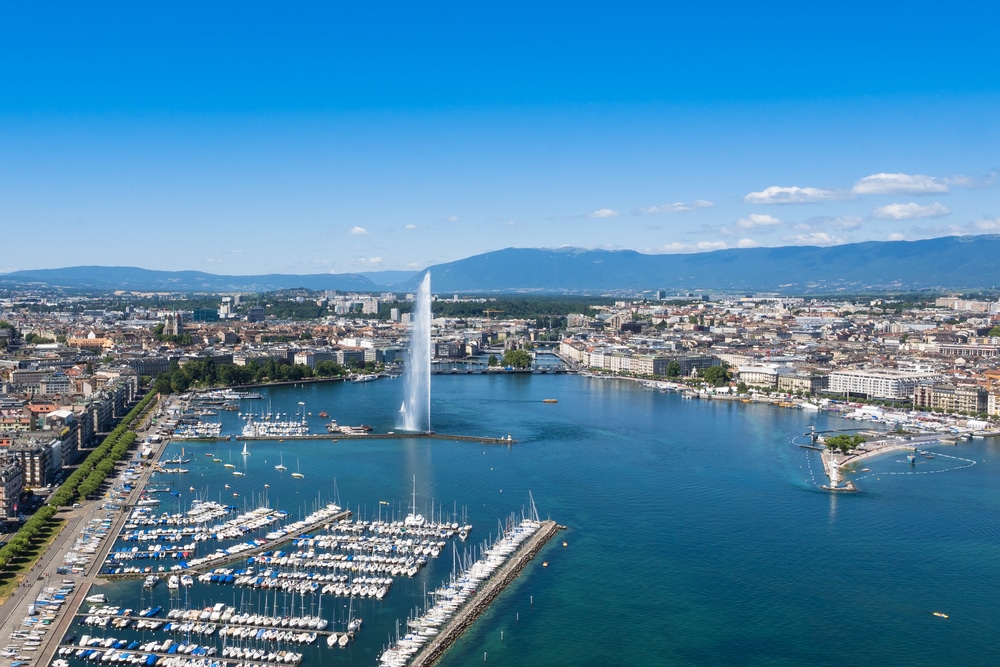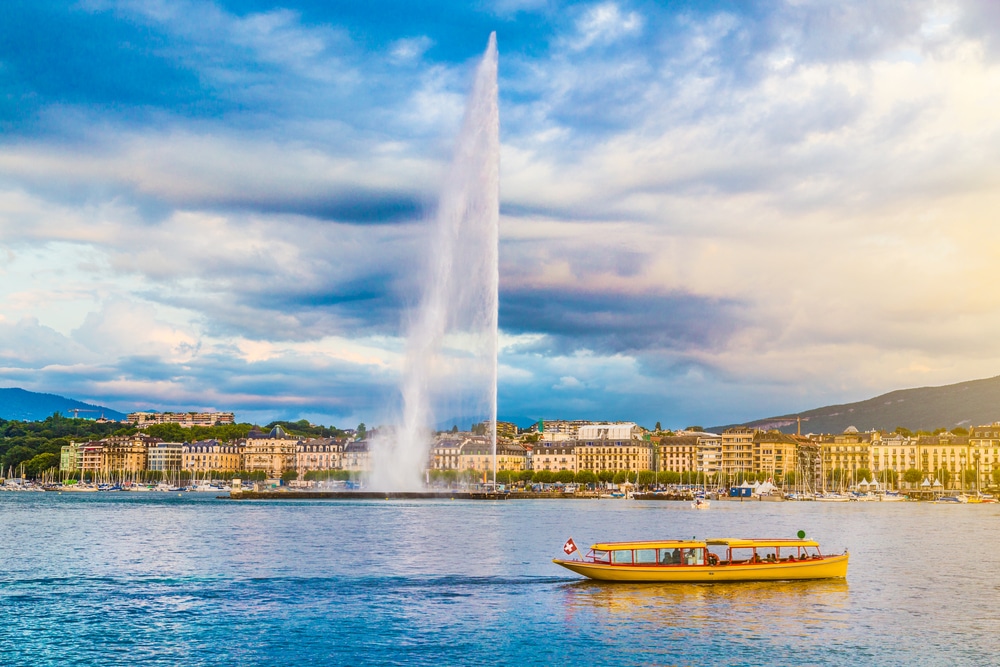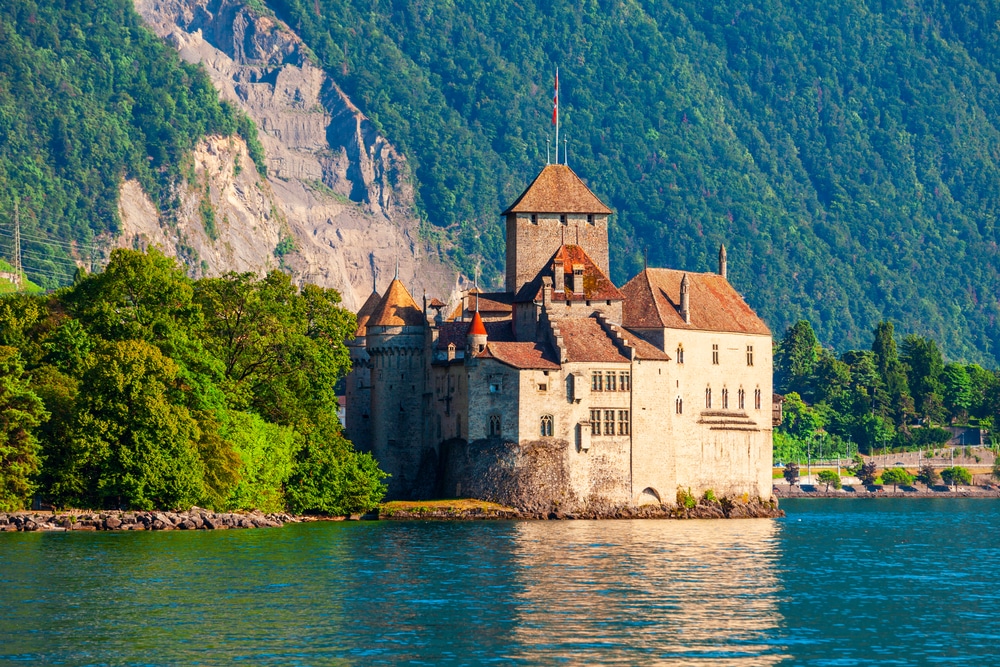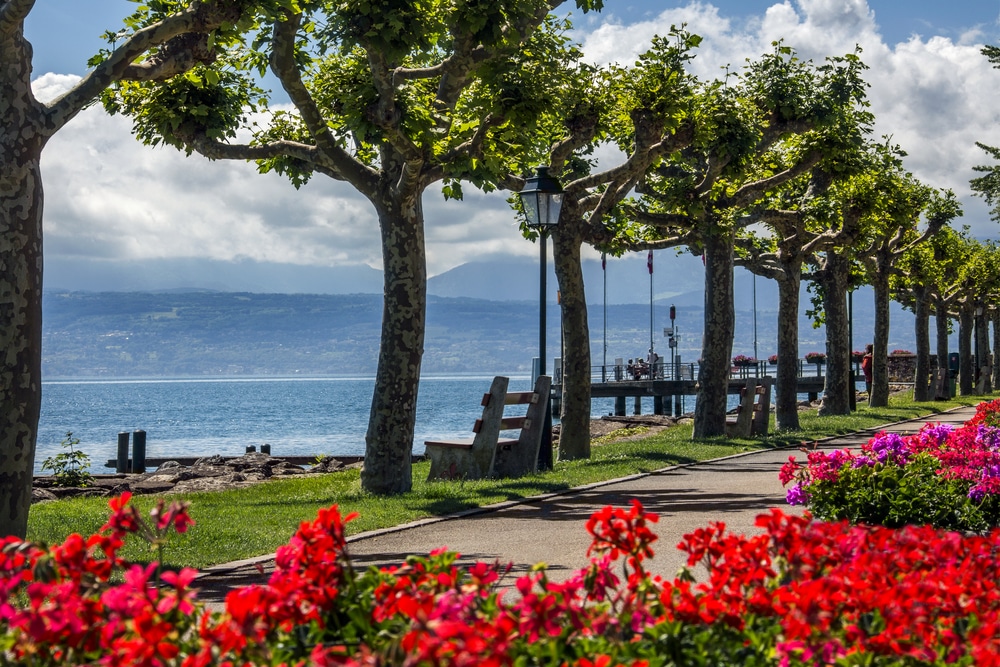Posted on 10 August 2023
When looking at European delights, Lake Geneva ticks all the boxes. The name “Lake Geneva” comes from the city of Geneva, which is at the lake’s western tip. The city of Geneva, in turn, takes its name from the Latin word “Genava,” which might have originated from the Celtic word “genawa,” meaning “bend” or “knee.”
The authorities formalised the name in the 18th century, and since then, the lake has continued to capture worldwide attention.For skiers, the lake also has special significance. Although, the lake isn’t situated in the skiing alpine plateaus. Since the lake is only 36 kilometres from Geneva airport, many alpine lovers take slight detours to enjoy Lake Geneva’s delights.
The Delights of Lake Geneva

1: Historical Influence on Switzerland
The history spans thousands of years and is intertwined with the region’s cultural, economic, and political developments. From prehistoric times, archaeological evidence suggests settlements existed around the lake as far back as the Bronze Age (around 1500 BCE). During the Roman era, the lake region belonged to the Roman province of Gallia Narbonensis. Roman settlements and roads were established, contributing to trade and communication.
In the early medieval periods, the strategic location made it essential for trade routes. The region witnessed conflicts between the House of Savoy, the Duchy of Savoy, and neighbouring powers, contributing to the dynamic history. The 16th-century Reformation reached the Geneva region, with figures like John Calvin shaping the religious and cultural landscape. This also marked the beginning of Bernese rule over the area.
The late 18th century brought French Revolutionary and Napoleonic influences. The area joined the Helvetic Republic under French control. While the 20th century saw the rise of tourism, drawn by natural beauty. During this time, the site also became famous for political and intellectual discussions, with notable figures like Lord Byron and Mary Shelley spending time here.
2: Geography of Lake Geneva
Between the Swiss and French Alps, Lake Geneva boasts of serenity and grandeur. As one of Europe’s largest lakes, Geneva spans approximately 580 square kilometres. The average depth is around 154 meters (505 feet). This measurement reflects the general middle point between the shallowest and deepest depths.The maximum depth reaches about 310 meters (1,017 feet) near the eastern end, making it one of Europe’s deepest lakes and the largest body of water in Switzerland.
From the north, Lausanne city graces hills with elegance. At the same time, further east lies the vibrant metropolis of Montreux, embraced by the Lavaux vineyards. To the west, Geneva City stands proudly against the backdrop of the Jura Mountains. The beautiful lake’s northern shore is framed by the Swiss Riviera, where charming towns like Vevey and Montreux exude classic charm. The eastern shore is watched over by the medieval castle of Chillon, perched on rocky outcrops.
3: Why is Lake Geneva in Switzerland Famous?
- International Borders: The crescent-shaped lake is shared between Switzerland and France, with about 60% of the surface area within Swiss territory and the rest in France.
- Glacial Origin: Lake Geneva was formed by glacial activity during the last Ice Age, around 15,000 years ago.
- Swiss Riviera: The northern shore is nicknamed the “Swiss Riviera,” characterised by Mediterranean-like climates and charming lakeside towns.
- Chateau De Chillon Castle: Chillon Castle, the medieval fortress near Montreux, is one of Europe’s most-visited historical landmarks. It stands on a rocky island just off the shore.
- Jet d’Eau: The iconic Jet d’Eau water fountain in Geneva shoots water up to 140 meters high at the point where Lake Geneva flows into the Rhône River.
- Lavaux Vineyards: The Lavaux UNESCO World Heritage Site features terraced vineyards producing some of Switzerland’s finest wines.
- Steamboats: Lake Geneva earns fame for historic Belle Époque-style steamboats that offer scenic cruises for tourists and locals alike.
- Lémanic Arc: The region is sometimes called “Lémanic Arc,” highlighting the economic and cultural importance.
- Underwater Archaeology: Lake Geneva’s depths hold archaeological treasures, including well-preserved shipwrecks and prehistoric settlements.
4: Explore Geneva City
Geneva, often called the “City of Peace,” is a captivating metropolis in Switzerland’s heart. Renowned for international diplomacy, stunning landscapes, and cultural richness, Geneva holds a prominent place on the global stage. Situated on Lake Geneva shores, with the majestic Alps as a backdrop, the city boasts picturesque settings that merge nature’s beauty with urban sophistication.

Home to numerous international organisations, including the United Nations and the Red Cross, Geneva signifies diplomacy, human rights, and humanitarian efforts. The cosmopolitan atmosphere is further enriched by a diverse population. The city’s vibrant cultural scene is also reflected in museums, art galleries, theatres, and music venues, catering to various tastes.
From the iconic Jet d’Eau fountain to the charming Old Town’s cobbled streets and historic landmarks, Geneva effortlessly combines tradition with modernity. The city’s reputation for excellence extends to its cuisine, with many gourmet restaurants offering a blend of Swiss specialities and international dishes.
5: Famous Montreux City
Montreux, a charming town nestled along the shores of Lake Geneva in Switzerland, earns fame for the Montreux Jazz Festival, which draws music enthusiasts worldwide. Held in July, it’s one of the most prestigious music festivals. Additionally, just a short distance from Montreux, Chillon Castle is a medieval fortress on a small rocky island in Lake Geneva. It’s one of Switzerland’s most visited historic sites, offering glimpses into the past with well-preserved architecture and picturesque location.
The promenade stretches along the lake, offering relaxing places to stroll, jog, or sit and enjoy the views. The well-maintained walkway is adorned with flowers, sculptures, and benches. Montreux’s international population adds to the cosmopolitan charm. The town’s cultural diversity is reflected in the culinary scene, with various restaurants serving international cuisine.
6: Get to Know Lausanne
As the capital of the Vaud canton, Lausanne offers history, culture, education, and stunning natural landscapes. The International Olympic Committee (IOC) is headquartered in Lausanne, earning the city the “Olympic Capital.” The Olympic Museum is also located here, offering an immersive experience of the history and significance of the Olympic Games.
Lausanne is home to the University of Lausanne (UNIL) and the École Polytechnique fédérale de Lausanne (EPFL), both internationally renowned institutions for higher education and research. The presence of these institutions adds youthful energy to the city. Lausanne’s historic Old Town (Vieille Ville) is characterised by narrow streets, medieval architecture, and charming squares. The 13th century Cathedral of Notre Dame, is a prominent landmark.
Like other towns along Lake Geneva, Lausanne boasts scenic lakeside promenades that offer stunning views of the lake and the French Alps. The promenade is perfect for leisurely walks, picnics, or simply enjoying the serenity of the surroundings. Otherwise, once an industrial area, the Flon district has become a lively and creative hub. It’s known for its eclectic mix of restaurants, bars, boutiques, and cultural spaces.
7: Other Swiss Towns and Villages Surrounding the Lake
Adjacent to Montreux, Vevey has a picturesque setting, the historic Chaplin’s World Museum, and its association with Nestlé’s headquarters. La Tour-de-Peilz town lies between Vevey and Montreux and features a lakeside chateau and a beautiful waterfront. Nyon offers historical sites, museums, a charming old town, and its own local beach. While Morges boasts lakeside parks, flower displays, and a lovely medieval town centre.
Saint-Gingolph village, with cobbled streets, straddles the Swiss-French border at the southwestern tip. Saint-Prex northern shore village offers historical buildings and serene lakeside settings. On the north shore, Cully excels in wine terraces, vineyards, and the Cully Jazz Festival. Lastly, Lutry boasts a medieval old town and laid-back lakeside atmospheres.
8: What is the Prettiest Town on Lake Geneva?
The prettiest place is over on the French side. Known for picturesque beauty and well-preserved historical architecture, Yvoire is nicknamed the “Most Beautiful Village of France.” The village exudes timeless atmospheres, with narrow cobbled streets, flower-filled courtyards, and enchanting buildings that date back to the Middle Ages. Yvoire’s location adds to the appeal by offering stunning lake and mountain views. The village’s waterfront is adorned with colourful boats, creating a serene and idyllic scene.
Visitors can leisurely stroll, exploring quaint shops, art galleries, and cafes. Yvoire is also renowned for well-maintained formal gardens, like the Jardin des Cinq Sens (Garden of the Five Senses), which engages visitors with sensory experiences through various plants and fragrances. Yvoire gets busy during peak travel seasons as a popular tourist destination.
9: Can you Swim in Lake Geneva?
Yes, you can swim in Lake Geneva. The clean waters and picturesque surroundings make the lake, popular for swimming, especially during warmer months. There are designated swimming areas and beaches where people can enjoy swimming and sunbathing. The water quality is generally good, and many of these designated areas have facilities, lifeguards, and safety measures to ensure enjoyable swimming experiences. Ideal beaches to visit for swimming include Bains des Pâquis (Pâquis Baths), Plage de la Savonnière, Plage de Préverenges, Plage d’Ivoire, Plage de Promenthoux, Plage de Rolle, and Plage de Prangins.
10: The Swiss Connection to Freddie Mercury
Freddie Mercury, the legendary lead vocalist of Queen, loved Lake Geneva. Freddie Mercury moved to Montreux and acquired a recording studio named “Mountain Studios”. Queen recorded several albums in Mountain Studios, including their iconic album “A Kind of Magic.”
The famous Freddie Mercury statue stands on the lakeside promenade in Montreux. The statue was erected in his memory and is popular with tourists. Visitors to Montreux can also explore the “Queen: The Studio Experience” exhibit at the Montreux Casino. This interactive museum showcases Queen’s history and their time recording at Mountain Studios.
11: Historical Churches
- St. Pierre Cathedral (Cathédrale Saint-Pierre) – Geneva: This iconic cathedral features Romanesque and Gothic architecture in the heart of Geneva’s Old Town. The archaeological site includes remains of earlier churches and opportunities to climb the tower for panoramic views.
- Lausanne Cathedral (Cathédrale Notre-Dame) – Lausanne: One of Switzerland’s most impressive Gothic cathedrals, Lausanne Cathedral overlooks the city and Lake Geneva. The stunning architecture and ornate facade make it a significant landmark.
- Church of St. Francis (Église Saint-François) – Lausanne: The Church of St. Francis displays Baroque architecture with distinctive pink colours. It is an elegant testament to the city’s historical and religious heritage.
- Chillon Castle Chapel – Montreux: Within the confines of Chillon Castle, you’ll find a charming chapel. Although relatively small, it adds to the castle’s medieval ambience and showcases the historical role of religion.
- Cathedral of Saint Nicholas – Fribourg (Fribourg Cathedral): Fribourg Cathedral is worth mentioning due to its proximity. The Gothic architecture and impressive facade make the cathedral a key city landmark.
- Saint Maurice Cathedral – Vienne (France): In Vienne town (France), Saint Maurice Cathedral is a historical site with Romanesque and Gothic architectural elements.
- Cathedral of Our Lady – Evian-les-Bains (France): This southern shore cathedral features neo-Gothic architecture.
12: Chateau De Chillon Castle
Château de Chillon Castle’s fascinating history spans centuries and features significant events, figures, and architectural developments. The castle’s ownership passed through various noble families but became particularly associated with the 13th-century Savoy dynasty. Chillon Castle was strategically positioned along Lake Geneva’s trade routes and served as a toll station, allowing owners to control trade between northern and southern Europe.

François Bonivard, a Genevan politician and dissident, was imprisoned in Château de Chillon. Lord Byron’s poem “The Prisoner of Chillon ” famously depicts his captivity.” In the 16th century, the Bernese took control of Chillon Castle. The castle then served as a Bernese administrative centre. But during the Napoleonic era, Chillon Castle’s military significance waned, and it was used as a prison for a short period. The Swiss Confederation acquired the castle in 1893, and has been open to the public as a museum since then.
Château de Chillon is one of Switzerland’s most visited historic sites, attracting tourists, history enthusiasts, and admirers of medieval architecture worldwide. Additionally, the entire Lavaux region, including Château de Chillon, is recognised as a UNESCO World Heritage Site, adding to global significance.
13: Interesting Museums to Visit Around Lake Geneva
Musée d’Art et d’Histoire Art and Historical Museum house diverse collections of art and historical artefacts, ranging from ancient Egyptian artefacts to European paintings and decorative arts. But head to the Patek Philippe Museum to see the Swiss art of watchmaking. Learn about the humanitarian efforts of the Red Cross and Red Crescent organisations through interactive exhibitions and multimedia presentations at their museum. Or for photography exhibitions, head to Musée de l’Élysée in Lausanne.
The Olympic Museum in Lausanne explores the history of the Olympic Games alongside famous athletes and events. While Chaplin’s World in Vevey showcases his life, career, and creative process through interactive displays and artefacts. Discover the history and evolution of Nestlé, one of the world’s largest food and beverage companies, through exhibitions that explore products, innovation, and impact in their museum at Vevey.
14: Natural Mineral Water Spring
Lake Geneva, or Lac Léman, is not a mineral spring surrounded by natural mineral spring water sources. The region, especially the Swiss canton of Vaud, is famous for high-quality mineral water from underground springs. They produce thousands of litres of water every month. The favourite Evian mineral water comes from nearby Evian-les-Bains. The water originates from Cachat Spring.
Additionally, Lavey-les-Bains has natural thermal springs enriched with minerals from surrounding rocks, used in thermal baths and wellness facilities. Yverdon-les-Bains, near the lake, also boasts natural thermal springs with mineral-rich water, as seen in thermal spa complexes. Montreux town on the northeastern shore has clean water sources, and some local springs provide natural drinking water from nearby mountains. Lastly, the nearby Valais region is also renowned for mineral springs, offering several mineral-rich water types.
15: Hiking Trails Around Lake Geneva
The Lake Geneva region offers several hiking trails showcasing the area’s beauty and Swiss history, from lakeside promenades to alpine trails with stunning mountain views. Firstly, explore the UNESCO-listed Lavaux vineyard terraces. These well-maintained paths offer panoramic lake views and the opportunity to discover the region’s famous vineyards. Otherwise, the Promenade Fleuri – Montreux lakeside promenade offers leisurely walking with picturesque lake views.
The Les Rochers-de-Naye Trail to Montreux trail rewards hikers with breathtaking panoramic vistas. While there is another scenic trail from Bouveret to the Le Grammont summit. The Sentier des Toblerones to Prangins historic trail follows the Toblerone Line route, a World War II defensive structure. Other lesser popular tracks but still rewarding include Caux to Rochers-de-Naye, Tour du Mont Pèlerin, Sentier des Narcissus, and Chemin de Plan
16: What are the Houses like Surrounding Lake Geneva?
Houses surrounding Lake Geneva exhibit architectural styles and designs that reflect rich history, cultural influences, and contemporary preferences. Along the shores, discover elegant historic villas and chateaus sitting among cobblestone streets that showcase architectural styles from different periods. Some properties date from the 19th century and earlier, reflecting luxury and sophistication.
The Belle Époque era left its mark, and many grand mansions built during this period still stand today. These houses often feature ornate facades, decorative details, and expansive gardens. Otherwise, in nearby Alpine villages and towns, expect traditional Swiss chalets with characteristic wooden construction, steep roofs, and cosy interiors.
You’ll also find modern residences with sleek lines, large windows, and innovative design elements alongside the historic architecture. Many modern houses maximise lake views and blend seamlessly with natural surroundings. In the Lavaux region, terraced vineyards often lead to charming homes that take advantage of stunning landscapes. These homes might be cosy yet straightforward, with terraces and gardens providing relaxation and outdoor living opportunities.
Some properties are designed explicitly as waterfront retreats, offering private jetties, boat docks, and direct access for residents to enjoy water activities and the peaceful ambience. One fascinating aspect is the architectural styles, ranging from Swiss chalets and French country houses to modern and minimalist designs.
17: Is Lake Geneva a Nice Place to Live?
Yes, Lake Geneva and its surrounding areas are considered beautiful places to live. The region offers a high quality of life with natural beauty, cultural richness, and economic opportunities. The region’s natural beauty also provides ample opportunities for outdoor activities.
The Lake Geneva area is home to a diverse international community because it is a global hub for diplomacy, business, and research. This diversity brings blends cultures, languages, and experiences. The Lake Geneva region boasts a robust economy with various job opportunities in finance, technology, healthcare, and international organisations. Significant cities like Geneva and Lausanne are known for their innovation and global connections.
The area is home to prestigious universities and research institutions. The high standard of education extends to primary and secondary schools as well. Switzerland, in general, has well-developed healthcare systems and high-quality infrastructure. The Lake Geneva region benefits from these features, offering reliable healthcare services and efficient transportation options.
The cities around Lake Geneva also have vibrant nightlife, restaurants serving diverse cuisines, and recreational facilities. Switzerland is known for political stability, safety, and well-functioning institutions, making the country, a secure place to live.
However, the cost of living in this region can be relatively high, particularly in major cities like Geneva and Lausanne. Housing costs, in particular, can be a significant consideration. Additionally, factors such as personal preferences, job opportunities, and lifestyle choices will determine whether Lake Geneva is the right place for an individual or family to live.
More about Geneva in Switzerland
Closest Ski Resorts: Geneva Airport, a smooth-operating air travel hub hosting flights worldwide, is a gateway to Swiss and French ski resorts. Additionally, ski property owners do not want lengthy transfers after their flight and would much prefer to get there and onto the ski slopes themselves in next to no time. We compiled this list of the closest ski resorts from Geneva airport for beginner and intermediate skiers and advanced. We also list what to expect in popular ski resorts, from snow parks to après ski, mountain restaurants, short airport transfers and more.


